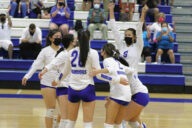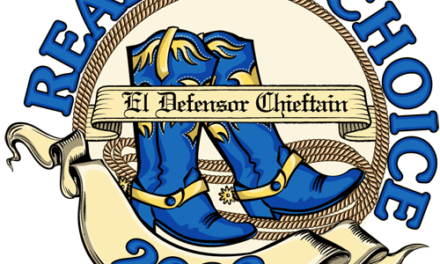
Skeeter Leard stands in her studio which is in the front of her house. She has been drawing since she was little and focuses on birds, horses and other animals. She also does a lot of landscapes.
Caitie Ihrig | El Defensor Chieftain photos
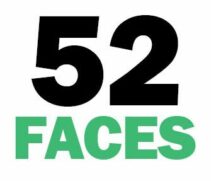
Leard made a life out of raising horses and in the arts. She owns Seekter’s Designs LLC in Socorro and mainly focuses on animal and landscape drawings.
She has published her own book about the quail she would find in her backyard and helped publish the first Navajo English dictionary.
How did you get into art and design?
I went to school and I hated everything at school except for reading. When they added drawing to the options, I was delighted. I happened to go to catholic school and they came down during those days probably a little more on the arts than the public schools did. I had teachers who were interested. By the time I was about 14, I had a teacher who had lent me her pastels and told me how to work with them. I bless her every day. I pray other things too, but that is No. 1. I went to a little bit of college on a scholarship and I was starting a career raising horses so I needed to come up with some more revenue. I went down and told Hallmark Cards that I was an artist and that I would like a job. They said, ‘go home and do some little tight watercolors of flowers for us.’ I did and they said they would hire me. I could draw. I had a good background in drawing and some background in watercolor. They showed me how to do the things they particularly wanted to do for their company. One-by-one, I learned to do them and that was in 1953 when I went to work for them. It was just one thing after another. I got to where I was doing illustrations and working for magazines and stuff. When I was out here for a while, I did two jobs out here. One of them was I helped put together the first illustrated Navajo English dictionary. They didn’t need any help drawing or with their language, but they didn’t know how to make a book happen. By then, I knew how to make a book happen. I went to work and we made the dictionary. I went to work for freelancing for a bunch called the SAGA Card Company in Albuquerque and that was in 1984. I worked for them until they sold it. I worked for the man who bought it over in Oklahoma for years and years. He got Alzheimer’s and he sold it to somebody who doesn’t do a very good job with it anymore and doesn’t pay royalties so that has spun out of control and is gone. It was just a running on my feet kind of thing.
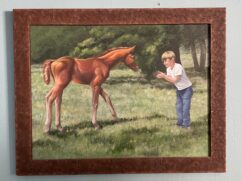
Getting to Know You is one of Leard’s favorite pieces as it features her son Robert when he was a kid and his horse Captain Rowdy.
How did you get involved with the dictionary?
They were looking for somebody who could help them run their publishing project. I didn’t do any drawing. There isn’t a word of mine in there. I just organized the publishing side of it. They have one at the library and for a long time, they were very, very expensive.
Why did you write a book?
I don’t know. That’s a really good question. Nobody has ever asked me that. Maybe I got tired of making people listen to me or look at the pictures on my computer or me sending them my pictures.
Why did you choose this topic?
I’m crazy about quail and most birds. There are birds I don’t like, but not very many. I have a quail here. I was living out on Perry Road and I had lots and lots of quail. As you see, lots of other things of interest. It wrote itself. It was nothing hard about writing it, but it took me about, off-and-on, three years to make the book because I could work on it for a little while, and then I had to go do a paying job. I sold out the first edition and have about five left of the second edition. I guess I oughta print it again because I hate for it to be out.
When did you come to Socorro?
In 1996. I was living in Cerrillos and we had kind of a dumpy place. It was not terribly expensive. We were coming down to the Bosque every time we could get a little time off. We decided that if we were going to look around for a place to live that we would come down and look at Socorro. Kathy Huff had a place to rent and we rented it. We were there from 1996 until 2014. My husband died that year. My friends in the area found us another place close by and helped me move. I still had one horse left and by means of friends, I got him to a good place. I was there for three years and then bought this little house. The idea being that I can walk to things here when I get too old to drive, which isn’t going to be too much longer. I like it here. There are a lot of things that frustrate me. I really can’t drive big trips now. I don’t even go by myself to Bosque. I don’t even go to Belen anymore. A couple of my friends do all of my errands for me.
How did you get involved with Bosque del Apache?
One time when my husband was in the hospital, he had a gal coming and doing some acupuncture. She said, ‘as much as you guys like birds and things, have you ever been to Bosque del Apache?’ We hadn’t and as soon as we had a chance, we came down. We were captivated… we moved down here and by that time, we were pretty familiar. When we did find a place to live for those 18 years, it was about six acres and my husband built a really big corral for the one horse. It had a decent little barn and hay storage… it was just a few miles from Bosque so we went there whenever we could. San Antonio was our address at that time.
What did you do for the Bosque?
I ran their store. Eventually, there were store ownership things that were really awkward and this one was with the Southwest Natural and Cultural Heritage Association. I worked for them and Friends had a store too and they were separate. It was really a mess. We got along OK, but it was awkward. People would have to go to two different cash registers. Finally, Friends managed to wrangle SNCHA out of there and they asked me if I wanted to run the Friends store. I didn’t. I felt like I would be stepping on the people I had worked for… I just didn’t feel right about it. I did do other work for them. They have a lot of the smaller stores like the store at Bosque.
How did you get into raising horses?
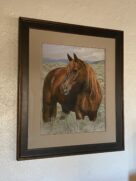
Stella is another one of Skeeter Leard’s favorite as she had that horse for 33 years.
I was born in love with horses. By the time I got to be nine, I had pestered my folks for a pony. I hated school, but they decided it might be easier to get me a pony and see if that would settle me down. They did and I did. His name was Thunder. I was nine, my mother turned me over to a couple of the teenage boys who had ponies and rode and said, ‘you teach her what she needs to know.’ They looked after me and the pony taught me how to ride. When that year was over, one of my teachers had outgrown his pony so I sold mine to a little kid and bought Jerry… by then I knew I wanted to raise horses for my life’s work. I did… I raised good ones and that’s how I got into New Mexico. People from St. Louis, I was at the other end of the state, had bought horses from me and were doing really well in shows. When they moved out here and took their horses out here and some people out here bought some from me and I brought them out. That was my first time in New Mexico.
Do most of your artworks focus on horses?
Probably more birds than anything. I really love the landscapes. I just get involved with birds and they are just endlessly fascinating.
What mediums do you work with?
Pastel is my weapon of choice, but I use acrylics too. There is an advantage to acrylics as you don’t have to glass them. You have to frame it, but you don’t have to glass it. That is attractive. The nice thing about acrylic is there is nothing between you and it and it is very, very durable. It’s a good medium because you can do almost anything in it. It’s not that expensive.
What is your favorite piece you have done?
Stella is one of the favorites. She belongs to my heart, from the get-go. There is one in the computer room (and) it’s getting to where it means more and more to me. I’ve had it for years and years and years. I don’t get to see the boy that’s in it. His unit is deployed. Robert and Captain Rowdy, they grew up together and had years and years of good times together. To me, it’s so peaceful. Its name is Getting to Know You. That and Stella are duking it out.
If you could change one thing about Socorro, what would it be and why?
I wish that we could work together as a community and basically bag the politics for a while. I’m one of the ones who would stand out on the sidewalk with signs, but it gets in our way. The things we are going to have to change, just not in Socorro, but in the United States of America and the rest of the world too, are really drastic and we are 40 years behind. Fiddle farting around like we are is going to have to stop… we are going to have to work harder, and yet we have a lot of community spirit and a lot of people who just give and give. Everybody is going to have to overhaul their attitudes… the people at Alamo are 70 miles away. Magdalena is cute, but Magdalena is not a place where you can make a living. If you are going to make a living, you are going to have to come here. There is no bus service. Most of the Navajos are driving some sort of wrecky car that uses too much gas and falls apart… The state needs to run the Railrunner all the way down to the border. That would help every community. Our little transit here does take people up to Belen, but that is the kind of thing we are going to have to fix and we can’t do it and be all hokey pokey about what party you belong to… For the most part, people here are really kind. The cops and the mayor and the fire department, if you have to deal with them, they are really civilized people and helpful in ways that you just don’t find everywhere you go. That’s adventitious… maybe that’s what I wish for Socorro – that we always be good to each other and we do that a lot. I would like to just build on that.



